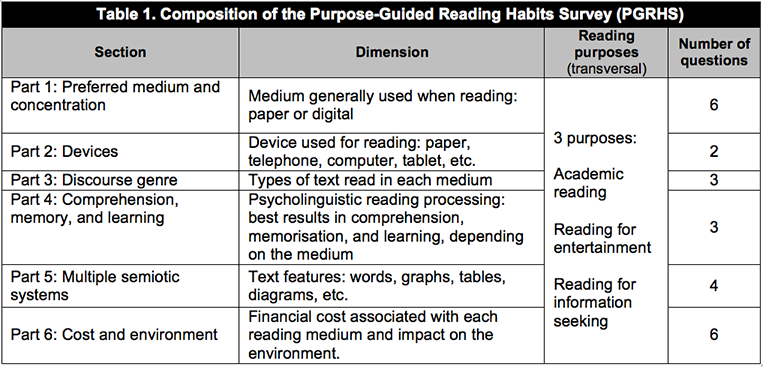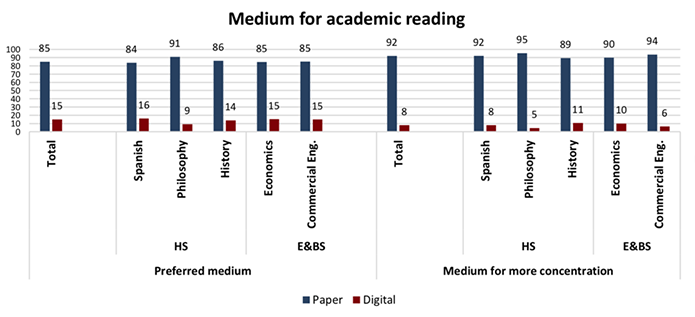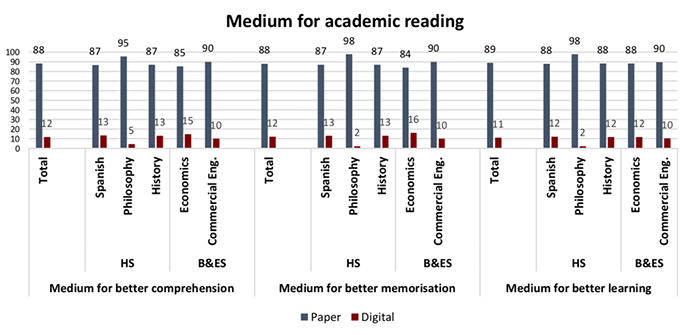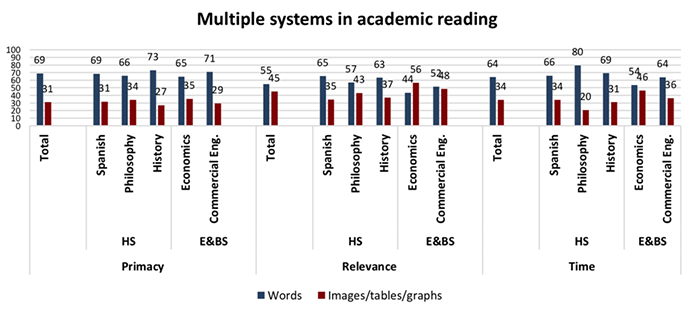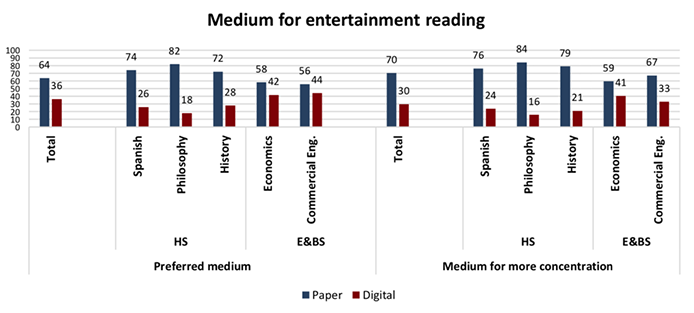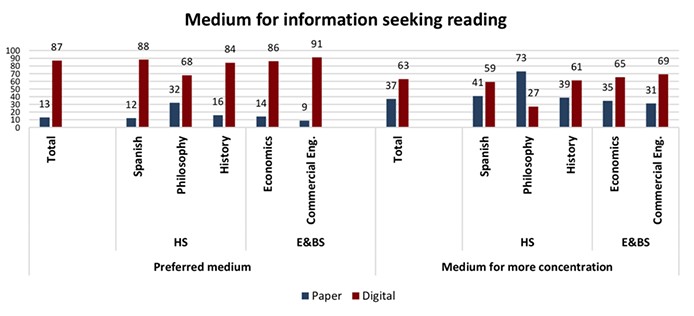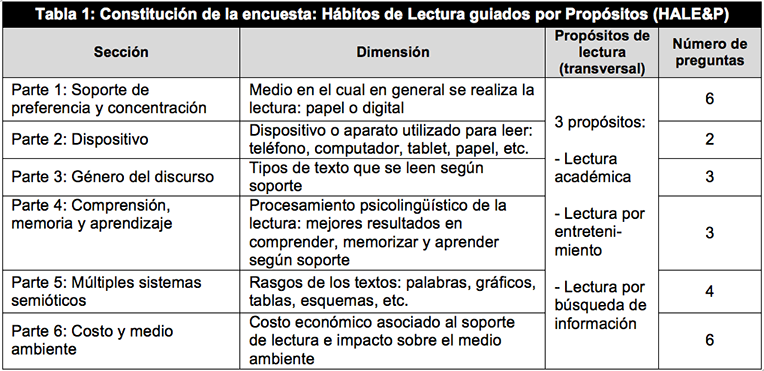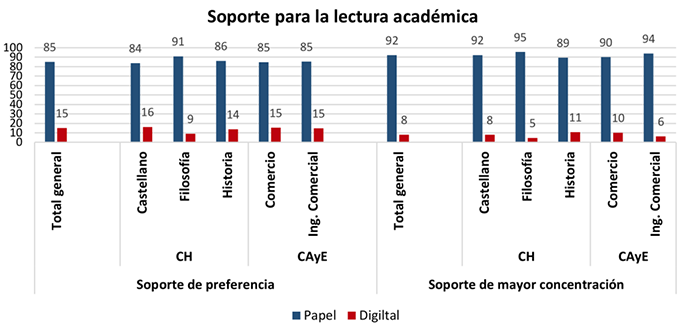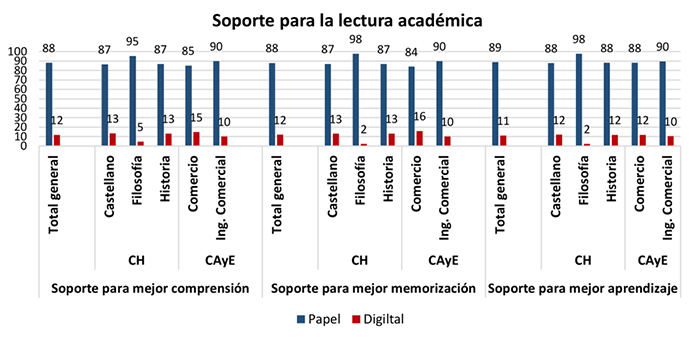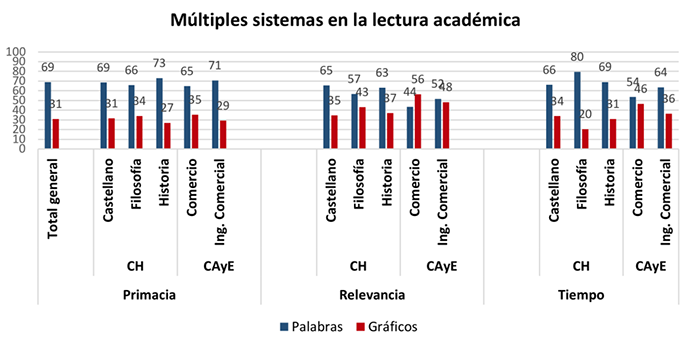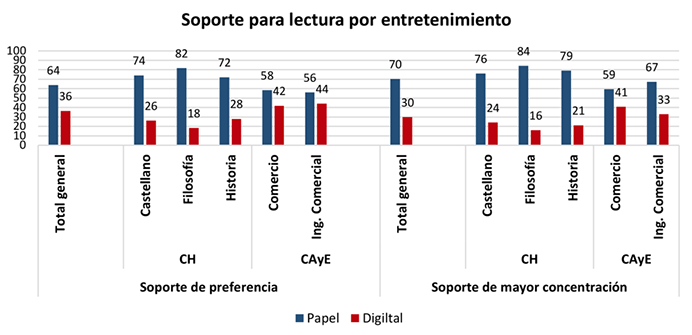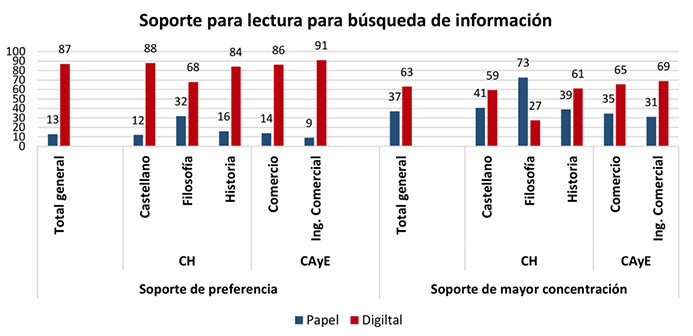(Created page with "<span style="color:#FFFFFF; background:#ffffcc"><span id="article_es"></span>Pulsa aquí para ver la versión en Español (ES)</span> ==== Abstract ==== It ha...") |
m (Scipediacontent moved page Draft Content 347708300 to Parodi et al 2019a) |
(No difference)
| |
Revision as of 14:15, 27 March 2019
Pulsa aquí para ver la versión en Español (ES)
Abstract
It has always been in the public interest to know the reading habits of readers of various ages and levels of schooling, as well as their opinions with regard to the consumption of reading materials. Lately, researchers have given increased attention to digital texts. Although progress on these topics has been made as reported in published research, there is yet incomplete information regarding readers’ habits and opinions at university and professional levels. This study describes the self-reported habits of university students belonging to two disciplinary domains (Human Sciences and Economic and Business Sciences) regarding reading on paper or on digital media for three purposes: academic, entertainment, and information seeking. The results reveal that the readers’ preferences vary according to the three purposes. These readers reported using different media but had a clear preference for paper; they also reported distinguishing between cognitive processes (memory, comprehension, and learning), with the discipline to which they belonged having no radical effect on their preferences. All of this leads us to conclude that currently there exists a generation in transition, a ‘Gutenberg-Google’ generation, which still recognizes the relevance of paper, in particular for academic purposes.
1. Introduction
Reading often attracts the attention of experts and laypeople. In particular, two concerns commonly arise: Are we reading enough? And, what are we reading? In other words, the focus of attention is on how much people read and what they read. More recently, researchers have tackled questions relating to the emergence of new technologies and their effect on reading on paper and other media and digital devices. Therefore, identifying the reading habits reported by readers of different ages and levels of education and their opinions on the consumption of printed and digital materials, formats, and media, is highly valuable to both governmental authorities and researchers. Whether it be with the aim of influencing public policy or with scientific or applied objectives, it is a crucial priority to have access to detailed information on how groups from different disciplinary fields and levels of schooling carry out their everyday reading practices (Woody, Daniel, & Baker, 2010; Carr, 2011; Baron, 2015; Wang & Bai, 2016).
Underlying these concerns, there is a set of assumptions, hypotheses and predictions (many of which lack sufficient scientific evidence) revealing reservations about statements such as a) people do not read enough, b) written culture has become impoverished, c) nowadays people read less than they used to, d) books on paper will soon disappear, e) digital reading involves new ways of thinking, and f) young people mostly read on electronic devices.
In addition, another preoccupation has emerged more recently: can reading texts in a digital medium have negative effects? In other words, what are the cognitive implications of reading in different media, printed or digital? Is one more efficient than the other? The fear is that new media would have a negative impact on reasoning, i.e., that new technological devices lead to a decrease in reflexive reading and deep and lasting learning (Bennett, Maton, & Kervin, 2008; Rockinson-Szapkiw, Courduff, Carter, & Bennett, 2013; Mangen, Walgermo, & Bronnick, 2013; Beland & Murphy, 2016).
In our opinion, the information available on these issues remains fragmented and lacks a perspective that adequately deals with reading purposes as a central focus of the processes implied in the comprehension of written texts and different reading devices. Although there is still no integral systematic theory involving reading objectives, numerous researchers recognise that people read for many different purposes and that they adapt their reading processes to those objectives (Graesser, Singer, & Trabasso, 1994; Graesser, Li, & Feng, 2015; Parodi, 2011; Britt, Rouet, & Durik, 2018).
This study is part of a larger research project that aims to identify reading habits, written materials and reading routes using eye-tracking technology in different disciplinary domains (FONDECYT Project 1170623). The reading habits survey employed here was designed and administered to university students as part of the first stages of this research grant. The survey focuses on the reading habits of students as they read for different purposes; at the same time, it seeks to collect detailed information on discourse genres and their multisemiotic features. The objective of the current study is to describe the reading habits disclosed by university students in two disciplinary areas (Human Sciences and Economic and Business Sciences) regarding paper and digital media with three reading purposes: academic, entertainment and information seeking.
This study presents the results of the administration of the Purpose-Guided Reading Habits Survey (PGRHS) for three of the six dimensions included in the survey: 1) Preferred medium and concentration for reading; 2) Comprehension, memory and learning; 3) Multiple semiotic systems. Consequently, the focus of the study is to describe the central findings related to the incidence of three specific reading purposes. The article is organised as follows: the first section reviews some key issues that frame the design of the survey. The methodology section provides details of the procedure through which the instrument was built, the sample of university students and the administrative procedures. This is followed by a review of the general results of the study and a discussion of the findings. The article concludes with projections.
1.1. Reading on paper and digitalmedia : Readers’ habits and academic performance
In an article published in 2007, Marianne Peronard reflected on the differences between reading on paper and computer screen and suggested the need for digital reading to take into account “the needs and interests of each person, for each moment, and for each purpose” (Peronard, 2007: 179). Previously, Muter and Maurutto (1991) had listed 29 formal features that previous studies identified as possible factors of the differences between reading on paper and on screen. Because of the varied data collection methodologies, Dillon (1992) stated that it was not possible to draw definitive conclusions about the particularities that contributed to possible differences. The study by Peronard (2007) confirmed the assertion made by Piolat, Roussey, and Thuning (1997) that comprehending a text was more efficient for a group of university students when the text was read on paper than in a digital medium. Reading on the latter device also revealed poorer spatial memory and more superficial text processing. These findings coincide with most recent studies (Sparrow, Liu, & Wegner, 2011; Mangen & al., 2013; Mangen & van-der-Weel, 2016; Hou, Rashid, & Lee, 2017) and are part of the current debate about new generations of readers and their supposed preference of digital media over paper (Selwyn, 2009; Carr, 2011; Baron, 2015).
From this framework, we are interested in approaching another source of information, which is the focus of the current study: opinion surveys. In general, the importance given to reading habits surveys is related to their impact on other relevant dimensions of the reading process. Recent research has revealed that there is a relationship between reading habits and academic performance. Usually, students who proclaim themselves dedicated readers tend to score better on school tests (Molina, 2006; Galicia & Villuendas, 2011; Picasso-Pozo, Villanelo-Ninapaytan, & Bedoya-Arboleda, 2015). Thus, the underlying assumption that guides and inspires much of the research in this domain is that reading habits facilitate and foster the development of reading comprehension competence and positively influence students’ academic performance. Although our objectives are not the same as Peronard’s (2007), hers and related findings that show a connection between reading habits and academic performance provide relevant background to the present study.
1.2. Natives, immigrants and the Google Generation: Terminological successes and failures
Together with the widening proliferation of information technology, different characterisations of human groups have arisen, particularly in the area of education. Gallardo, Marqués, Bullen, and Strijbos (2015) identified at least 48 different terms for users of digital technology in the literature from 1991 to 2014. Within this possible terminological confusion, a relatively accepted categorisation, though one that is still not free from controversy, is the distinction between digital natives and digital immigrants, based on the date of birth of subjects from different generations and associating this with a particular relationship to the digital world.
The terms digital native and digital immigrant arose at the end of the 1990s (Prensky, 2001a). Digital natives would be young people born in the 90s who are the first generation of the technological revolution and who grew up surrounded by artefacts from the digital era. Although lacking empirical basis, Prensky (2001b) suggests that this environment of permanent interaction with technological tools modifies the structure of the brain and the thinking processes of users. Digital immigrants, on the other hand, would be those who did not grow up with this technology and had to learn about new cultures and ways of communication in order to join the modern digital world.
Another somewhat controversial categorisation focuses on technological practices applied by certain users, proposing the existence of the so-called Google Generation. It identifies people born after 1993 who live in a world of permanent connectivity, use the internet as their only source of information and use Google as their main search engine (Rowlands, Nicholas, Williams, Huntington, Fieldhouse, Gunter, Withey, Jamali, Dobrowolski, & Tenopir, 2008; Gunter, Rowlands, & Nicholas, 2009; Nicholas, Rowlands, Clark, & Williams, 2010).
Much of what was stated before 2008 on digital natives and the educational implications of their characteristics lacks empirical evidence (Bullen, Morgan, & Qayyum, 2011). Although the terms digital native and digital immigrant are used regularly, there is considerable debate regarding their use and the related findings reported. One such debate questions the appropriateness of creating generational dichotomies of this kind. Some studies indicate that differences attributed to age are minimal (Salajan, Schönwetter, & Cleghorn, 2010). Even Prensky (2009) came to believe that the distinction was irrelevant and proposed the concept of digital wisdom. Some empirical studies have shown that there are no fundamental differences between digital natives and digital immigrants (Selwyn, 2009; Corrin, Lockyer, & Bennett, 2010), and if any, they would be basically due to experience, access and opportunity to use technology (Brown & Czerniewicz, 2010; Czerniewicz & Brown, 2010).
As it can be seen, generalisations based on apparent generational differences are not useful in discussions related to teaching and learning (Gallardo & al., 2015) and they often constitute incomplete descriptions or myths, as was concluded by Rowlands and others (2008) as well as Nicholas and others (2011) in their studies of the characteristics of users from the so-called Google Generation. Overall, there are other contextual variables, apart from age, such as socioeconomic status and cultural and ethnic precedence, that can explain the differences in the way people use technology (Jones, Ramanau, Cross, & Healing, 2010).
2. Materials and methods
2.1. The survey
The PGRHS is comprised of 24 questions divided into six sections. Most of the questions are closed and have multiple-choice answers (19 of the 24). Each of the six sections focuses on a dimension of reading that we believe relevant in the modern world, with the aim of identifying how that dimension can affect the reading habits of university students. The table below shows the six sections, the respective dimensions, the three transversal reading purposes and their distribution over the questions.
The objective of the survey is to analyse reading habits relative to different media and devices and to identify associated discourse genres and their multisemiotic features, all within the framework of three reading purposes: a) reading of academic texts, b) reading for entertainment, and c) reading for information seeking. In general terms, we were interested in identifying whether readers vary their reading habits depending on the media and devices being used, given different specific purposes. The survey was built by the research team FONDECYT, Project 1170623. Three concurrent and complementary sources of information were used to construct the final survey: 1) Consultation with a group of three specialists regarding medium, content, and types of questions; 2) Pilot administration on a sample of students in the same degree programs, but at other universities than those included in the study; 3) Interviews with students from universities other than the target sample. This process led to changes in medium and changes in wording or terminology where this was unclear; all of these modifications were incorporated into the final design.
2.2. Stratified random sampling
In order to obtain a diverse sample of students and avoid possible variations in discipline, students were chosen from two groups of university degree programs: Human Sciences (HS), which include Philosophy, Spanish and History; and Economic and Business Sciences (E&BS), which include Commercial Engineering and Economics.
The survey was administered at two regional Chilean universities, one in Valparaíso and the other in Concepción. Both are private but receive public funding, as is common in Chile. We used random and stratified sampling and had a total of 894 subjects. The sample was designed to include an equal proportion of males and females. Table 2 shows the distribution per university program.
For a population of 1,788 university students, proportional stratified random sampling was used, suggesting that the proportion of students in HS compared to E&BS is 1:1.5. The minimum sample size was estimated on the basis of the Student t-test for independent samples, giving a total of 894 subjects from the following parameters: a) a level of significance p=.05, b) effect size d=.2, and c) statistical power (1-B) =.9. This number of participants was stratified in accordance with the following variables: a) study area, b) institution, c) degree program, and d) gender. The calculation resulted in the subdivision shown in Table 2. A sample of this nature allows greater representation and, therefore, better extrapolation of the subsequent findings.
2.3. Administration and coding procedures
Surveys were administered at random to the 894 students from the undergraduate degree programs (the mean age was 20 years, SD=2.7). Randomness was ensured by the use of a computer program that selected numbers at random from a list of each course. The self-administered surveys were conducted on paper with the support of a team of six research assistants who were given the appropriate training beforehand. It was decided to use a strategy that allowed for better control of the characteristics defined for the sample (degree, gender), ensuring that the responses from the interviewees were obtained more quickly than they would by using alternative methods, for example, online surveys.
Previous to the administration of the survey, a written consent form was given to the students, indicating that their participation was voluntary and that any data given would be anonymous and confidential. Administration of the survey took, on average, 15 to 20 minutes. The responses were then coded on a spreadsheet. All statistical analysis (t-test) was carried out using the same software (Excel/SPSS).
3. Results
As stated in the introduction, the results presented in this article constitute a first report from the administration of the reading survey PGRHS. More precisely, the focus here is on the results of three dimensions: a) preferred medium for reading and concentration, b) comprehension, memory and learning, and c) multiple semiotic systems. Figure 1 shows the results for preference and concentration for academic reading.
As it can be observed, the figures are highly homogenous. In all cases, they give a result of over 84% in favour of the paper medium. The students state that they prefer reading on paper for academic purposes in general and because they are able to concentrate better. The statistical analyses reveal that all comparisons between paper and digital media are statistically significant in favour of paper (https://goo.gl/F2bQhr).
These first figures, in view of a reading purpose as relevant as the academic one, are very revealing regarding the preferences of this group of university students. These results are consistent with other findings of our own research team (Parodi & Julio, 2017) and other studies in Spanish and in English (Baron, 2015; Salvador-Oliván & Agustín-La Cruz, 2015; Beland & Murphy, 2016; Wang & Bai, 2016). However, as stated above, there are few surveys that take into account reading purposes and degree programs as variables in their design. Therefore, this result can be interpreted in two dimensions: students identify the reading purpose, and they prefer the paper. This is regardless of the degree program involved.
Figure 1 also shows that, for the purpose of academic reading, the students declare that paper is better for concentration. Similarly, in a study conducted in Turkey with a sample of 792 university students from eight different departments, Kazanci (2015) reported that in general, the students show a high preference of 78% for paper over digital. The same study also reveals that after six years, the same university students did not vary their preference for paper (77%). Moreover, Farinosi, Lim, and Roll (2016) identified, in a sample of students from Germany, Italy, and the UK, a preference for paper when processing large genres for academic purposes. These results did not reveal socio-economic differences among the nationalities of the participants, whose ages varied from 21.9 years to 26.9 years. Similar results were obtained by Baron (2015) for a group of subjects from the USA, Germany, and Japan, who stated that when reading long texts for academic purposes they opted for paper (92% in the US, 95% in Germany and 77% in Japan).
Figure 1. Academic reading: Preference and concentration.
Our results align with those from other parts of the world mentioned above. It is clear that there is a high degree of preference for paper among university students across countries and cultures.
The following section, maintaining the focus on academic reading, reports the results on comprehension, memorisation, and learning.
The data in Figure 2 again show a highly homogenous panorama, revealing in all cases a result of over 84% in favour of reading on paper. The students in the sample (again irrespective of their degree program) state that when reading for academic reasons, paper medium gives better results for comprehension, memorisation, and learning. As with Figure 1, the statistical analyses of the figures show that all comparisons between paper and digital are statistically significant in favour of paper (https://goo.gl/Xme7sJ).
Figure 2. Academic Reading: Comprehension, memorisation, and learning.
Despite the hypothesis of possible preferences for reading on digital medium in the so-called Google Generation (Rowlands & al., 2008; Nicholas & al., 2010), the results reported here for the purpose of academic reading show that these Chilean university students prefer paper for comprehension, memorisation, and learning. These findings are in line with those of university students of other nationalities (Woody & al., 2010; Mangen & al., 2013; Baron, 2015; Wang & Bai, 2016).
Strictly speaking, a total of 98% of the students in the sample can be classified as belonging to the Google Generation, as they were born after 1993. Only 2% were aged between 27 and 47 at the time of the survey. Nevertheless, the younger readers state that in their academic reading, for better comprehension, memorisation, and learning, they prefer paper. They even state that they employ the digital medium mainly for searching and selecting texts, but that once a text has been found and the purpose changes from searching to academic reading, they proceed to print the text. The results at this point are relatively homogenous, with no significant differences among degree programs. Furthermore, a higher percentage of the students states that if the cost were not a factor and there was no environmental impact, they would prefer to print digital texts for more dedicated reading and comprehension. Similar results were found in genres read for the purpose of entertainment, such as comic books. Though not reported here in detail, it can be noted that upon comparing the results for men and women, no statistically significant differences were found.
Based on these results, the students in this survey can more accurately be considered part of the Gutenberg Generation, or considered comparable to so-called digital immigrants, in spite of belonging to an age range that would have defined them otherwise. Particularly for academic reading tasks, they consistently prefer reading on paper.
Figure 3 below shows the results on primacy (what is read first), relevance (what is more important) and time (what captures more time) regarding the verbal system and other semiotic systems, such as images, tables, and graphs.
Figure 3. Academic reading with multiple semiotic systems: Primacy, relevance and time.
When the students were asked, in the context of academic reading, what they read first in a text made up of words, images, tables or graphs, the majority answered that their attention is focused on the verbal system, i.e., the words (69%). As shown in Figure 3, the same answer is given for all degree programs in a relatively homogeneous way. In general, this result shows that, although the students place importance on reading images, tables, and graphs, they are influenced by the Logocentric Principle, i.e., that words dominate or have pre-eminence over other semiotic systems (Parodi & Julio, 2017).
The following figure summaries the statistical data for the second reading purpose: reading for entertainment.
Figure 4 displays an interesting difference between the students from the three programs in HS and the two from E&BS. All the students from HS state that when reading for entertainment, their preferences tend towards reading on paper, with the majority stating that reading on paper helps improve concentration. In this line, Baron’s findings (2015) indicate that university students of different nationalities also prefer paper when reading for pleasure (85% in the US, 88% in Germany and 74% in Japan). Similar to previous findings, statistical analyses for this reading purpose reveal that all comparisons favoured paper medium (https://goo.gl/BEBgqY).
Figure 4. Reading for entertainment: Preference and concentration.
Finally, Figure 5 shows the results for the third reading purpose: information seeking.
Figure 5. Reading for information seeking: Preference and concentration.
Interestingly, when the reading purpose is information seeking, the preferences of most of the students in the sample, irrespective of the degree program, clearly indicate that they favour the digital medium (global mean 87%). This result is the opposite of what was observed in the previous cases and is the only occasion on which most of the readers show a general preference for the digital medium. Almost all statistical analyses show that comparisons between paper and digital are statistically significant in favour of digital (https://goo.gl/Z2cEp3).
In particular, the case of Philosophy is noteworthy. 68% of the Philosophy students state that when searching for information, they preferred a digital medium. However, the same students declare that for the same reading purpose but for more concentration, they prefer the paper medium (73%). The case of these Philosophy students is unique among the five programs of the present study, even when compared to the other Human Sciences programs (Spanish and History). The data in Figure 5 clearly suggest the awareness students have of their own reading purposes and the effect these reading purposes have on the medium they subsequently choose.
4. Conclusions
The evidence presented in this study shows first that the university students in the stratified sample of five programs clearly distinguish the three reading purposes and connect them to specific media, tasks and the multisemiotic composition of written texts. The findings are also revealing since surveys of reading habits do not regularly include reading purposes. These purposes can be seen as a variable that positively affects the reading habits declared by the sample of Chilean subjects.
Second, the general findings also reveal that paper is the preferred medium for the university students in the sample, as opposed to the digital one, given study purposes and academic rigour. In addition to this, we found no statistically significant differences for academic reading purposes by discipline, defined here as whether students belonged to the Human Sciences or the Economic and Business Sciences programs.
According to the findings of the current study and other similar studies, being born after a somehow Messianic date (such as 1993) is not a sine qua non-condition for being a predominantly digital reader. This underlines the need to distinguish between technology use for entertainment purposes and information seeking, and for academic purposes for the construction of deep and lasting learning. Consequently, it is correct to claim the existence of a ‘Gutenberg-Google Generation’ in transition that still recognises the relevance of paper medium. At the same time, attention must be paid to empirical studies that state that digital reading on different electronic devices leads to superficial and shallow processing and low retention, unlike reading on paper which yields deeper comprehension and improved learning (Sparrow & al., 2011; Baron, 2015; Kazanci, 2015; Mangen & van der Weel, 2016; Hou, Rashid, & Lee, 2017).
Overall, it is worth emphasising that the findings reported here are based on declared habits and on the opinions of the interviewees. This means that the focus of our study is on declarative knowledge, i.e., what the subjects state they do, not exactly on what they do or exercise when they read (procedural knowledge). In other research, we have focused on discourse processing and studied different variables in moment to moment and online reading (Parodi & Julio, 2017; Parodi, Julio, & Recio, 2018).
Funding Agency
Research Project FONDECYT 1170623 (2017-2020) “Are there different routes for reading multi-semiotic texts in professionals of different disciplinary backgrounds: Philosophy and economics? Descriptive and experimental study using eye tracker”.
References
Baron, N. (2015). Words onscreen. The fate of reading in a digital world. Oxford: Oxford University Press.
Beland, L., & Murphy, R. (2016). III Communication: Technology, distraction & student performance. Labour Economics, 41, 61-76. https://doi.org/10.1016/j.labeco.2016.04.004
Bennett, S., Maton, K., & Kervin, L. (2008). The ‘digital natives’ debate: A critical review of the evidence. British Journal of Educational Technology, 39(5), 775-786. https://doi.org/10.1111/j.1467-8535.2007.00793.x
Britt, M., Rouet, J., & Durik, A. (2018). Literacy beyond text comprehension. A theory of purposeful reading. Nueva York: Routledge.
Brown, C., & Czerniewicz, L. (2010). Debunking the ‘digital natives’: Beyond digital apartheid, towards digital democracy. Journal of Computer Assisted Learning, 26(5), 357-369. https://doi.org/10.1111/j.1365-2729.2010.00369.x
Bullen, M., Morgan, T., & Qayyum, A. (2011). Digital learners in higher education: Generation is not the issue. Canadian Journal of Learning and Technology, 37(1), 1-24. https://doi.org/10.21432/T2NC7B
Carr, N. (2011). The shallows. What the Internet is doing to our brains. Nueva York: Norton & Company.
Corrin, L., Lockyer, L., & Bennett, S. (2010). Technological diversity: An investigation of students’ technology use in everyday life and academic study. Learning, Media and Technology, 35(4), 387-401. https://doi.org/10.1080/17439884.2010.531024
Czerniewicz, L., & Brown, C. (2010). Born into the digital age in the south of Africa: The reconfiguration of the ‘digital citizen’. In L. Dirckinck Holmfeld, V. Hodgson, C. Jones, M. de-Laat, D. McConnell, & T. Ryberg, (Eds.), Proceedings of the 7th Inte
Dillon, A. (1992). Reading from paper versus screens: A critical review of the empirical literature. Ergonomics, 35(10), 1297-1326. https://doi.org/10.1080/00140139208967394
Farinosi, M., Lim, C., & Roll, J. (2016). Book or screen, pen or keyboard? A cross-cultural sociological analysis of writing and reading habits basing on Germany, Italy and the UK. Telematics and Informatics, 33(2), 410-421. https://doi.org/10.1016/j.tel
Galicia, J., & Villuendas, E. (2011). Relación entre hábitos lectores, el uso de biblioteca y el rendimiento académico en una muestra de estudiantes de psicología. Revista de la Educación Superior, enero-marzo, XL(1), 55-73. https://goo.gl/fX6oTK
Gallardo, E., Marqués, L., Bullen, M., & Strijbos, J. W. (2015). Let’s talk about digital learners in the digital era. International Review of Research in Open and Distance Learning, 16(3), 156-187. https://doi.org/10.19173/irrodl.v16i3.2196
Graesser, A., Li, H., & Feng, S. (2015). Constructing inferences in naturalistic reading contexts. In E. O’Brien, A. Cook & R. Lorch, (Eds.), Inferences during reading (pp. 290-320). Cambridge: Cambridge University Press. https://doi.org/10.1017/CBO97811
Graesser, C., Singer, M., & Trabasso, T. (1994). Constructing inferences during narrative text comprehension. Psychological Review, 101(3), 371-395. https://doi.org/10.1037/0033-295X.101.3.371
Gunter, B., Rowlands, I., & Nicholas, D. (2009). The Google Generation: Are ICT innovations changing information-seeking behaviour? Cambridge: Chandos Publishing. https://doi.org/10.1533/9781780631639
Hou, J., Rashid, J., & Lee, K. (2017). Cognitive map or medium materiality? Reading on paper and screen. Computers in Human Behavior, 67, 84-94. https://doi.org/10.1016/j.chb.2016.10.014
Human-Computer Studies, 47(4), 565-589. https://doi.org/10.1006/ijhc.1997.0145
Jones, C., Ramanau, R., Cross, S., & Healing, G. (2010). Net generation or digital natives: Is there a distinct new generation entering university? Computers & Education, 54(3), 722-732. https://doi.org/10.1016/j.compedu.2009.09.022
Kazanci, Z. (2015). University students’ preferences of reading from a printed paper or a digital screen – A longitudinal study. International Journal of Culture and History, 1, 50-53. https://doi.org/10.18178/ijch.2015.1.1.009
Mangen, A., & van-der-Weel, A. (2016). The evolution of reading in the age of digitisation: an integrative framework for reading research. Literacy, 50, 116-124. https://doi.org/10.1111/lit.12086
Mangen, A., Walgermo, B., & Bronnick, K. (2013). Reading linear texts on paper versus computer screen: Effects on reading comprehension. International Journal of Educational Research, 58, 61-68. https://doi.org/10.1016/j.ijer.2012.12.002
Molina, K. (2006). Lectura y educación: los hábitos lectores y su repercusión académica en le Educación Secundaria Obligatoria. Ocnos, 2, 103-121. https://doi.org/10.18239/ocnos_2006.02.07
Muter, P., & Maurutto, P. (1991). Reading and skimming from computer screens and books: The paperless office revisited? Behavior and Information Technology, 10(4), 257-266. https://doi.org/10.1080/01449299108924288
Nicholas, D., Rowlands, I., Clark, D., & Williams, P. (2011). Google Generation II: Web behaviour experiments with the BBC. Aslib Proceedings, 63(1), 28-45. https://doi.org/10.1108/00012531111103768
Parodi, G. (2011). La Teoría de la Comunicabilidad: Apuntes para una concepción integral de la comprensión de textos escritos. Signos, 44(76), 145-167. https://doi.org/10.4067/S0718-09342011000200004
Parodi, G., & Julio, C. (2017). More than words: Contending semiotic systems and the role of disciplinary knowledge in specialized text comprehension. Revista Ibérica, 33, 11-36. https://goo.gl/f52nhF
Parodi, G., Julio, C., & Recio, I. (2018). When words and graphs move the eyes: The processing of multimodal causal relations. Journal of Eye Movements Research, 11(1), 1-18. https://doi.org/10.16910/jemr.11.1.5
Peronard, M. (2007). Lectura en papel y en pantalla de computador. Signos, 40(63), 179-195. https://doi.org/10.4067/S0718-09342007000100009
Picasso-Pozo, M., Villanelo-Ninapaytan, M., & Bedoya-Arboleda, L. (2015). Hábitos de lectura y estudio y su relación con el rendimiento académico en estudiantes de odontología de una universidad peruana. Kiru, 12(1) 19-27. https://bit.ly/2OOjmqw
Piolat, A. Roussey, J.Y., & Thuning, O. (1997). Effects of screen presentation on text reading and revising. International Journal of
Prensky, M. (2001a). Digital natives, digital immigrants, Part 1. On the Horizon, 9(5), 1-6. https://doi.org/10.1108/10748120110424816
Prensky, M. (2001b). Digital natives, digital immigrants, Part II: Do they really think differently? On the Horizon, 9(6), 1-9. https://doi.org/10.1108/10748120110424843
Prensky, M. (2009). H. Sapiens digital: From digital immigrants and digital natives to digital wisdom digital wisdom. Innovate, 5(3). https://goo.gl/HQf85v
Rockinson-Szapkiw, A., Courduff, J., Carter, K., & Bennett, D. (2013). Electronic versus traditional print textbooks: A comparison study on the influence of university students’ learning. Computers & Education, 63, 259-266. https://doi.org/10.1016/j.comp
Rowlands, I., Nicholas, D., Williams, P., Huntington, P., Fieldhouse, M., Gunter, B., Withey, R., Jamali, H., Dobrowolski, T., & Tenopir, C. (2008). The Google generation: The information behaviour of the researcher of the future. Aslib Proceedings, 60(4)
Salajan, F., Schönwetter, D., & Cleghorn, B. (2010). Student and faculty inter-generational digital divide: Fact or fiction? Computers & Education, 55(3), 1393-1403. https://doi.org/10.1016/j.compedu.2010.06.017
Salvador-Oliván, J., & Agustín-Lacruz, M. (2015). Hábitos de lectura y consumo de información en estudiante de la Facultad de Filosofía y Letras de la Universidad de Zaragoza. Anales de Documentación, 18(1), 1-15. https://doi.org/10.6018/analesdoc.18.1.2
Selwyn, N. (2009). The digital native – myth and reality. Aslib Proceedings, 61(4), 364-379. https://doi.org/10.1108/00012530910973776
Sparrow, B., Liu, J., & Wegner, D. (2011). Google effects on memory: Cognitive consequences of having information at our fingertips. Science, 333, 776-778. https://doi.org/10.1126/science.1207745
Wang, S., & Bai, X. (2016). University students awareness, Usage and attitude towards e-books: Experience from China. The Journal of Academic Librarianship, 42(3), 247-258. https://doi.org/10.1016/j.acalib.2016.01.001
Woody, W., Daniel, D., & Baker, C. (2010). E-book or textbooks: Students prefer textbooks. Computers & Education, 55, 945-948. https://doi.org/10.1016/j.compedu.2010.04.005
Click to see the English version (EN)
Resumen
Conocer los hábitos de lectura de sujetos de diversas edades y niveles de escolarización, así como su opinión respecto del consumo de materiales de lectura, ha estado siempre en el interés público. En los últimos tiempos, mayor énfasis se ha puesto en los textos digitales. Si bien se ha avanzado en la investigación en estas áreas, aun es parcial la información a nivel universitario y profesional. En este estudio se describen los hábitos declarados por estudiantes universitarios de dos áreas disciplinares (ciencias humanas y ciencias económicas y administrativas) respecto de lectura en formato papel y en digital en virtud de tres propósitos: académico, entretenimiento y búsqueda de información. Para ello, se diseñó y aplicó una encuesta a una muestra de 894 estudiantes en dos universidades chilenas y en cinco carreras. Los resultados revelan que los lectores muestran variación en sus preferencias de lectura según los tres propósitos. En otras palabras, estos lectores declaran emplear soportes diferentes, pero con una clara tendencia a preferir mayoritariamente el sustrato papel, y distinguir procesos cognitivos diversos (memoria, comprensión y aprendizaje), sin que el área disciplinar de procedencia incida de modo radical en sus preferencias. Todo ello, en general, nos lleva a concluir que en la actualidad existe una generación en transición «Gutenberg-Google», la cual aún reconoce y otorga alta relevancia al soporte papel, en particular frente a propósitos académicos.
1. Introducción
El tema de la lectura suele atraer la atención de expertos y legos. En particular, se detectan dos inquietudes permanentes: ¿estamos leyendo lo suficiente?, ¿qué estamos leyendo? En otras palabras, el foco de atención está en cuánto se lee y qué se lee. Junto a ello, más recientemente, se han instalado otras interrogantes que tienen relación con la aparición de las nuevas tecnologías y sus efectos sobre la lectura en papel y en otros soportes y dispositivos digitales. De este modo, conocer los hábitos de lectura declarados por lectores de diversas edades y niveles de escolarización, así como la opinión respecto del consumo de materiales impresos y digitales, soportes y medios, resulta altamente valioso para diversas entidades, instituciones gubernamentales e investigadores. Tener acceso a información detallada acerca de lo que grupos de distinta procedencia y niveles etarios estiman y llevan a cabo en sus prácticas cotidianas de lectura es una preocupación constante, con mayor énfasis en los últimos años, ya sea con propósitos de incidir en la política pública o con objetivos científicos o aplicados (Woody, Daniel, & Baker, 2010; Carr, 2011; Baron, 2015; Wang & Bai, 2016).
A la base de estas preocupaciones subyace un conjunto de supuestos, hipótesis y predicciones (muchos no comprobados de modo científico) que revelan inquietud ante cuestiones tales como: a) no se lee lo suficiente; b) la cultura escrita se ha empobrecido; c) hoy se lee menos que antes; d) se avecina la desaparición del libro en papel; e) la lectura digital implica nuevos modos de razonar; f) los jóvenes, en mayor medida, leen preferentemente en dispositivos electrónicos.
Junto a lo anterior, últimamente se ha sumado otra inquietud: ¿tiene incidencias negativas la lectura en formato digital? Dicho de otra forma, ¿qué implicaciones cognitivas provoca la variación en el soporte de lectura: impreso o digital? o ¿existe uno más eficiente que otro? El argumento refleja la relación con que los nuevos soportes estarían produciendo un perjuicio en los modos de pensar y de razonar, es decir, los nuevos dispositivos tecnológicos conllevarían un detrimento en la lectura reflexiva y en el aprendizaje perdurable (Bennett, Maton, & Kervin, 2008; Rockinson-Szapkiw, Courduff, Carter, & Bennett, 2013; Mangen, Walgermo, & Bronnick, 2013; Beland & Murphy, 2016).
En nuestra opinión, aún es fragmentaria la información disponible en estos temas y se carece de una perspectiva que atienda suficientemente a los propósitos de lectura como ejes centrales en la comprensión de textos escritos y los diversos dispositivos de lectura. Si bien aún no se cuenta con una teoría integral que incorpore de modo sistemático los objetivos de lectura, diversos investigadores sí reconocen que las personas leen por muchas razones y que adaptan sus procesos de lectura a tales objetivos (Graesser, Singer, & Trabasso, 1994; Graesser, Li, & Feng, 2015; Parodi, 2011; Britt, Rouet, & Durik, 2018).
En este contexto, como parte de un proyecto mayor que busca conocer los hábitos de lectura, los materiales escritos y las rutas de lectura mediante técnicas de registro de movimientos oculares («eye tracking») de profesionales en ejercicio en diversas áreas del conocimiento (Proyecto FONDECYT 1170623), en una primera instancia, se decidió diseñar una encuesta de hábitos lectores para estudiantes universitarios. Dicha encuesta está enfocada en los hábitos de lectura de textos escritos en diversos formatos y soportes en relación con propósitos de lectura y busca, al mismo tiempo, recoger información detallada acerca de los géneros discursivos y de sus rasgos multisemióticos. El objetivo de este estudio es describir los hábitos lectores declarados por estudiantes universitarios en dos áreas disciplinares (ciencias humanas y ciencias económicas y administrativas) respecto de lectura en papel y en digital en virtud de tres propósitos de lectura: académico, entretenimiento y búsqueda de información.
Este artículo presenta los resultados a partir de la aplicación de la encuesta de hábitos de lectura guiados por Propósitos (HALE&P) en tres de las seis dimensiones presentes en la encuesta: 1) Soporte de preferencia y concentración para lectura; 2) Comprensión, memoria y aprendizaje; 3) Múltiples sistemas semióticos. Consecuentemente, nos concentramos en describir los hallazgos centrales que apuntan relación con la incidencia de los tres propósitos de lectura señalados. El artículo se organiza del siguiente modo: en la primera parte revisamos algunos temas centrales que encuadran el diseño y aplicación de la encuesta. El marco metodológico aporta detalles del procedimiento de construcción del instrumento, la muestra de sujetos y los procedimientos de aplicación. Posteriormente, nos concentramos en ofrecer un panorama de los resultados generales y discutir los principales hallazgos. Cerramos el artículo con proyecciones.
1.1. Leer en papel y en digital: hábitos lectores y rendimiento académico
En un artículo publicado en 2007, Marianne Peronard reflexionaba acerca de las diferencias entre la lectura en papel y pantalla de computador y sugería la necesidad de que la lectura digital debía tomar en cuenta «las necesidades e intereses de cada persona, para cada momento, y para cada propósito» (Peronard, 2007: 179). Con anterioridad, Muter y Maurutto (1991) habían confeccionado una lista de veintinueve rasgos formales que estudios previos identificaron como posibles determinantes de las diferencias entre la lectura en papel y en pantalla. Debido a las variadas metodologías de recolección de datos, Dillon (1992) declaraba que no fue posible establecer conclusiones definitivas acerca de las particularidades que contribuían a las posibles diferencias. Por su parte, el estudio de Peronard (2007) corroboró lo aseverado por Piolat, Roussey y Thuning (1997) en cuanto a que la comprensión de un texto resultó más eficiente para un grupo de estudiantes universitarios, cuando el texto se leía en formato papel que en digital. La lectura en este último dispositivo también reveló una memoria espacial más pobre y un procesamiento del texto de forma más superficial. Estos hallazgos coinciden con las investigaciones más recientes (Sparrow, Liu, & Wegner, 2011; Mangen & al., 2013; Mangen & Van-der-Weel, 2016; Hou, Rashid, & Lee, 2017) y se insertan en el debate actual acerca de las nuevas generaciones de lectores y su supuesta superioridad digital sobre el formato papel (Selwyn, 2009; Carr, 2011; Baron, 2015).
Desde este marco, nos interesa aproximarnos a otra vertiente de información, que es el foco del presente estudio: las encuestas de opinión. En general, la importancia otorgada a las encuestas de hábitos lectores tiene relación con su incidencia en otras relevantes dimensiones del proceso lector. La investigación reciente ha evidenciado que existe una relación entre hábitos lectores y rendimiento académico, de forma tal que suele existir una tendencia entre los estudiantes que declaran mayor dedicación a la lectura a obtener mejores puntuaciones en las pruebas escolares (Molina, 2006; Galicia & Villuendas, 2011; Picasso-Pozo, Villanelo-Ninapaytan, & Bedoya-Arboleda, 2015). Entonces, el supuesto de base que orienta e inspira a muchas de las investigaciones en este dominio parte de la idea de que los hábitos de lectura facilitan y fomentan el desarrollo de la competencia en comprensión del discurso e influyen positivamente en el rendimiento académico de los estudiantes. Si bien, en el presente estudio no seguimos ese objetivo, tanto los resultados de Peronard (2007) como los hallazgos que vinculan hábitos declarados y rendimiento académico, se constituyen en antecedentes relevantes para los objetivos de este artículo.
1.2. Nativos, inmigrantes y «Generación Google»: Aciertos y desaciertos terminológicos
Junto con la masificación de las tecnologías de la información, surgieron diversas caracterizaciones de grupos humanos, en especial en el ámbito educativo. Gallardo, Marqués, Bullen y Strijbos (2015) identificaron al menos 48 términos distintos para nombrar a los usuarios de tecnología digital, en la literatura de 1991 a 2014. En un marco de cierta confusión terminológica, una categorización relativamente aceptada, aunque no exenta de polémica, es la que distingue entre nativos e inmigrantes digitales, basándose en los intervalos de nacimiento de los sujetos adscritos a cada generación y asociando este dato a una particular relación con el mundo digital.
Los términos nativo e inmigrante digital surgen a fines de los años noventa (Prensky, 2001a). Nativos digitales serían los jóvenes que, nacidos en la década de los noventa, constituyen la primera generación de la revolución tecnológica, rodeada de artefactos propios de la era digital. Prensky (2001b), aunque sin sustento empírico, sugiere incluso que este entorno de interacción permanente con las herramientas tecnológicas modifica la estructura cerebral y los procesos de pensamiento y procesamiento de la información de los usuarios. Serían inmigrantes digitales, en tanto, quienes no crecieron familiarizados con estas tecnologías y debieron aprender nuevas culturas y formas de comunicación para incorporarse al moderno mundo digital.
Un criterio categorizador algo diferente, aunque controvertido, propone la existencia de una llamada «Generación Google». En ella se identifica a los jóvenes nacidos a partir de 1993, caracterizados por vivir en un mundo de conectividad permanente, por utilizar Internet como única fuente de información y por tener a Google como su principal motor de búsqueda (Rowlands, & al., 2008; Gunter, Rowlands, & Nicholas, 2009; Nicholas, Rowlands, Clark, & Williams, 2010).
Mucho de lo afirmado antes de 2008 acerca de los nativos digitales y de las implicaciones educativas de sus características careció de evidencia empírica (Bullen, Morgan, & Qayyum, 2011). Por esto, aunque los términos nativo e inmigrante digital se emplean con cierta regularidad, ha existido un considerable debate con base en estudios empíricos. Entre otros, se cuestiona lo inadecuado o engañoso que resulta concebir dicotomías generacionales de este tipo. Al respecto, algunos estudios indican que las diferencias atribuibles al factor edad son mínimas (Salajan, Schönwetter, & Cleghorn, 2010). El mismo Prensky (2009) llega a considerar algo irrelevante esta distinción y propone hablar de sabiduría digital. Ciertos estudios empíricos han demostrado que no existen diferencias fundamentales entre nativos e inmigrantes digitales (Selwyn, 2009; Corrin, Lockyer, & Bennett, 2010) y que, de existir, se deberían fundamentalmente a la experiencia, el acceso y la oportunidad para usar las tecnologías (Brown & Czerniewicz, 2010; Czerniewicz & Brown, 2010).
Es posible, entonces, apreciar que generalizaciones basadas en aparentes diferencias generacionales no resultan del todo útiles para las discusiones relativas a la enseñanza y el aprendizaje (Gallardo & al., 2015) y muchas veces son descripciones parciales o mitos, como concluyen Rowlands y otros (2008) y Nicholas y otros (2011), al estudiar detenidamente las características de los usuarios de la denominada «Generación Google». En definitiva, existen otras variables contextuales aparte de la edad, tales como el estatus socio-económico y la procedencia cultural y étnica, para explicar diferencias en las formas de utilizar las tecnologías (Jones, Ramanau, Cross, & Healing, 2010).
2. Metodología
2.1. La encuesta
La encuesta de HALE&P se compone de veinticuatro preguntas distribuidas en seis secciones. La mayoría de las preguntas son de tipo cerrado con alternativas (19 de las 24). Cada una de las seis secciones apunta a una dimensión de la lectura que juzgamos relevante en el mundo actual y desde la cual nos interesa conocer cómo podrían verse afectados los hábitos de los lectores universitarios. La siguiente tabla muestra las seis secciones, las dimensiones implicadas, los tres propósitos de lectura transversales a las preguntas y su distribución por preguntas.
El objetivo de la encuesta es conocer los hábitos de lectura de textos en diversos soportes y dispositivos, así como identificar géneros discursivos asociados y sus rasgos multisemióticos, todos enmarcados desde tres propósitos de lectura: a) Lectura de textos académicos; b) Lectura por entretenimiento; c) Lectura para buscar información. En términos generales, nos motivaba la idea de identificar si los lectores establecían diferencias en sus hábitos de lectura ante diferentes soportes y dispositivos, toda vez que se los enmarcaba desde un propósito diverso.
La encuesta fue construida por el equipo de investigadores del Proyecto FONDECYT Nº 1170623. Para llegar a su formato final, se procedió mediante tres fuentes concurrentes y complementarias de información: 1) Consulta a un grupo de tres especialistas acerca de su formato, contenidos y tipos de preguntas; 2) Aplicación piloto a una muestra de sujetos de las mismas carreras, pero de otras instituciones universitarias que no fueran las de objeto de estudio; 3) Entrevistas a estudiantes de instituciones diferentes a las de la muestra meta. De las tres fuentes consultadas, se identificaron cuestiones de formato, sugerencias de redacción, y problemas de ambigüedad terminológica o poca claridad de foco. Toda esta información concurrente fue integrada en el diseño final.
2.2. Muestreo aleatorio estratificado
Con el fin de obtener un panorama diversificado de la procedencia de los estudiantes y pesquisar eventuales variaciones disciplinares, optamos por incluir dos grupos de carreras universitarias: ciencias humanas (CH): pedagogía en filosofía, pedagogía en castellano y pedagogía en historia; y ciencias económicas y administrativas (CEyA): ingeniería comercial y comercio.
La encuesta fue aplicada en dos universidades regionales chilenas (una en Valparaíso y la otra en Concepción) con un muestreo aleatorio y estratificado (894 sujetos). Ambas universidades son privadas, pero -en el contexto chileno- reciben aportes gubernamentales a través de diversos mecanismos institucionalizados. La muestra también fue diseñada incluyendo una proporcionalidad de mujeres y hombres. La Tabla 2 muestra la distribución por carrera.
Para una población de 1.788 estudiantes universitarios, se empleó un muestreo aleatorio estratificado proporcional que sugiere que la proporción de estudiantes de CH vs CEyA es de 1:1.5. El tamaño muestral mínimo requerido se estimó sobre la base de la utilización de la prueba estadística t de Student para muestras independientes que arrojó un total de 894 sujetos, considerando los siguientes parámetros: a) nivel de significancia p=.05, b) tamaño del efecto d=.2, y c) potencia estadística (1-B)=.9. Este número de participantes fue estratificado de acuerdo a las siguientes variables: a) área de estudio; b) institución; c) carrera; d) sexo. Este ejercicio dio como resultado la subdivisión mostrada en la Tabla 2. Un muestreo de esta naturaleza permite alcanzar una mejor representatividad y, por ende, permite realizar una mejor extrapolación de los hallazgos a la población de origen.
2.3. Procedimiento de aplicación y codificación
Las encuestas se aplicaron aleatoriamente a los 894 alumnos de las carreras de pregrado indicadas en la muestra (edad promedio 20 años, DS 2,7). La aleatorización se aseguró usando un programa computacional que seleccionaba números al azar de la lista de cada curso en los que se aplicó la encuesta. Las encuestas fueron aplicadas presencialmente y en formato papel en las salas de clase de las carreras seleccionadas por seis encuestadores previamente entrenados. Se optó por esta estrategia de aplicación ya que se puede controlar mejor las características definidas para la muestra (carrera, sexo), es más segura la obtención de una respuesta por parte de los encuestados y resulta más rápida en comparación con otros métodos, por ejemplo, en línea.
Antes de la aplicación, un consentimiento informado les fue entregado a los alumnos en el que se les indicaba que su participación era voluntaria y que los datos entregados eran anónimos y confidenciales. La aplicación de la encuesta duró, en promedio, 15 a 20 minutos. Las encuestas contestadas luego fueron codificadas a una planilla de datos. Todos los análisis estadísticos (t-test) se llevaron a cabo usando los programas Excel y SPSS.
3. Resultados
Tal como adelantáramos en la introducción, los resultados aquí entregados constituyen un primer reporte a partir de la aplicación de la encuesta HALE&P. De modo más preciso, nos focalizamos en los resultados de tres dimensiones: a) Preferencia del soporte para lectura y concentración; b) Comprensión, memoria y aprendizaje; c) Múltiples sistemas semióticos. El Gráfico 1 muestra los resultados de preferencia y concentración para una lectura académica.
Gráfico 1. Propósito de lectura académica: preferencia y concentración.
Según se aprecia, las cifras alcanzadas son tremendamente homogéneas y muestran en todos los casos un resultado sobre el 84% que favorece el soporte papel. Los estudiantes de la muestra declaran que, con el propósito de una lectura académica, el sustrato papel es el preferido en términos generales y es el que les brinda mejores resultados para la concentración. Los análisis estadísticos indican que todas las comparaciones entre soporte papel y soporte digital son estadísticamente significativas a favor del papel (https://bit.ly/2L7VPO8).
Estas primeras cifras, ante un propósito de lectura tan relevante como el académico, se muestran muy reveladoras respecto de las preferencias de este grupo de estudiantes universitarios. Estos resultados son coincidentes con otros hallazgos de nuestro propio equipo (Parodi & Julio, 2017) y con otras publicaciones tanto en español como en inglés (Baron, 2015; Salvador-Oliván & Agustín-Lacruz, 2015; Beland & Murphy, 2016; Wang & Bai, 2016). No obstante, tal como señalamos anteriormente, son escasas o nulas las encuestas que acogen los propósitos de lectura y la disciplinariedad como variables centrales de su diseño, por lo que este resultado se debe interpretar con una doble lectura: se distingue el propósito de lectura y se opta por el formato papel, indistintamente de la carrera disciplinar de procedencia.
También en el Gráfico 1 se muestra que –en el marco de la lectura académica– el formato papel es el que, en opinión de los encuestados, potencia una mejor concentración. Coincidentemente, Kazanci (2015), en un estudio desarrollado en Turquía con una muestra de 792 estudiantes universitarios de ocho departamentos, reportó que –en términos generales– los estudiantes entrevistados muestran una alta preferencia a favor del formato papel en contraste con el digital, 78% y 22% respectivamente. Es más, el estudio de Kazanci (2015) revela que, después de seis años, los mismos lectores universitarios no variaron su preferencia a favor del sustrato papel. Por su parte, Farinosi, Lim y Roll (2016) con una muestra de sujetos de Alemania, Italia y Reino Unido también detectan una preferencia por el formato papel, cuando se deben procesar géneros de larga extensión para propósitos académicos. Dichos resultados no arrojaron mayores diferencias socioculturales entre las nacionalidades de los participantes, cuyas edades fluctuaban entre 21,9 y 26,9 años. Resultados similares obtiene Baron (2015) para un grupo de lectores de EEUU, Alemania y Japón. Ellos declaran que, cuando deben leer textos extensos para objetivos académicos, optan por el formato papel (92% en EEUU, 95% en Alemania y 77% en Japón).
A partir de los resultados del presente estudio y los citados en otras partes del mundo, es evidente la similitud del resultado global. Sus preferencias lectoras muestran ser muy semejantes en cuanto a soporte papel y digital.
En lo que sigue, los resultados en cuanto comprensión, memorización y aprendizaje.
Como es fácil apreciar, los datos reportados en el Gráfico 2, muestran nuevamente un panorama altamente homogéneo y revelan en todos los casos un resultado sobre el 84% a favor de una lectura en papel. Los estudiantes de la muestra (indistintamente de la disciplina de origen) declaran que, con el propósito de una lectura académica, el soporte papel les brinda mejores resultados en comprensión, en memorización y en aprendizaje. Del mismo modo que para los datos del Gráfico 1, los análisis estadísticos para las cifras del Gráfico 2 también indican que todas las comparaciones entre soporte papel y soporte digital son estadísticamente significativas a favor del papel (https://bit.ly/2PppohN).
Gráfico 2. Propósito de lectura académica: comprensión, memorización y aprendizaje.
Contrariamente a lo señalado respecto de las posibles preferencias de lectura en soporte digital para la llamada «Generación Google» (Rowlands & al., 2008; Nicholas & al., 2010), a la luz de los resultados aquí reportados, al menos en cuanto a objetivos de lectura académica o de estudio, estos lectores universitarios chilenos declaran preferir el sustrato papel para comprender, memorizar y aprender. Estos hallazgos son coincidentes para estudiantes universitarios de otras diversas nacionalidades (Woody & al., 2010; Mangen & al., 2013; Baron, 2015; Wang & Bai, 2016).
En sentido estricto, el 98% de estos estudiantes podría ser clasificado como «Generación Google», pues ellos nacieron después de 1993. Solo un escaso 2% de nuestros estudiantes tiene a la fecha de la encuesta entre 27 y 47 años. No obstante, estos lectores universitarios –en su mayoría– declaran que, para una lectura académica, prefieren el soporte papel. Incluso afirman que, el soporte digital lo utilizan mayoritariamente para la búsqueda y la selección de textos, pero cuando han cumplido ese propósito y cambian su objetivo por uno de estudio, proceden a imprimirlos. En este punto, los resultados obtenidos son relativamente homogéneos: la carrera de origen no muestra diferencias estadísticamente significativas. Aun más, un porcentaje mayor de estudiantes universitarios sostiene que, si el costo no fuera una condición y no se dañara el medio ambiente, preferirían imprimir los textos digitales para una lectura más dedicada y con comprensión; resultados similares se obtienen incluso en géneros de entretenimiento como es el cómic.
Complementariamente, cabe señalar que los resultados de la comparación entre mujeres y hombres no mostraron diferencias estadísticamente significativas.
Ante estos resultados, los estudiantes encuestados podrían más bien ser considerados como pertenecientes a la «Generación Gutenberg», o parecidos de cierto modo a los llamados inmigrantes digitales con más preferencia por el papel que por lo digital, aunque no ciertamente definidos por un rango etáreo preestablecido. Sobre todo, ante tareas de lectura académica, ellos consistentemente prefieren el formato papel.
El Gráfico 3, a continuación, en el contexto de un propósito de lectura académica, se pregunta por la primacía (qué se lee primero), la relevancia (qué aporta con mayor preeminencia), y el tiempo (a qué se dedica más tiempo de lectura) en relación al sistema verbal y otros sistemas semióticos tales como imágenes, tablas y gráficos.
Gráfico 3. Propósito de lectura académica de múltiples sistemas semióticos: primacía, relevancia y tiempo.
Cuando se les pregunta a los estudiantes de la muestra, en el contexto de un propósito de lectura académica, qué leerían primero ante textos compuestos por palabras, imágenes, tablas o gráficos, la mayoría de ellos responde que su atención iría al sistema verbal, es decir, a las palabras (69%). Tal como muestran las cifras del Gráfico 3, esta respuesta se obtiene en todas las carreras de manera relativamente homogénea. En términos generales, estos resultados indican que los estudiantes encuestados, aunque otorgan importancia a la lectura de imágenes, tablas y gráficos, ellos estarían influidos por el principio logocentrista, es decir, las palabras ejercen un dominio o preeminencia sobre otros sistemas semióticos (Parodi & Julio, 2017).
El siguiente gráfico resume los datos estadísticos porcentuales para el segundo propósito de lectura: por entretenimiento.
Los datos presentados en el gráfico anterior muestran una cierta diferencia entre los estudiantes de las tres carreras de ciencias humanas (CH) y las dos carreras de ciencias administrativas y económicas (CAyE). Todos los estudiantes encuestados de CH declaran que, ante un propósito de lectura por entretenimiento, sus preferencias se inclinan por leer en soporte papel; del mismo modo, expresan que mayoritariamente la lectura en papel les promueve mayor concentración. En este contexto, resulta oportuno señalar que los resultados de Baron (2015) también indican que estudiantes universitarios de distintas nacionalidades prefieren el papel para una lectura por placer (85% en EEUU, 88% en Alemania y 74% en Japón). Cabe señalar que los análisis estadísticos, en este caso, también muestran que todas las comparaciones favorecen al soporte papel (https://bit.ly/2BDkE5l).
Gráfico 4. Propósito de lectura por entretenimiento: preferencia y concentración.
Por último, el Gráfico 5 muestra los resultados para el propósito de búsqueda de información.
Gráfico 5. Propósito de lectura por búsqueda de información: preferencia y concentración.
Interesantemente, cuando varía el propósito de lectura y se pregunta por el soporte de lectura al momento de buscar información, las preferencias de la mayoría de los estudiantes de la muestra, indistintamente de su carrera de procedencia, indican –con claridad– que se prefiere el soporte digital (en promedio general 87%). Este resultado es contrario a lo observado en todos los casos anteriores y es la única vez en que la mayoría de los lectores encuestados se manifiestan sistemáticamente a favor del formato digital. Los análisis estadísticos indican que la mayoría de las comparaciones son estadísticamente significativas a favor del soporte digital (https://bit.ly/2wazjig).
En particular, llama la atención la situación de los estudiantes de filosofía, en que el 68% de los sujetos declara que, para este propósito, optan por el formato digital. Contrariamente, se debe agregar que estos mismos estudiantes de filosofía en un porcentaje mucho mayor (73%) expresan que cuando realizan una lectura para buscar información, la mayor concentración la alcanzan en formato papel. El caso de los estudiantes de filosofía resalta en el contexto de las cinco carreras encuestadas, incluso comparativamente con los de castellano e historia. Los datos reportados en este gráfico indican con mucha claridad la conciencia que tienen los estudiantes de la muestra de los propósitos de lectura y de su incidencia en el soporte de lectura.
4. Conclusiones
La evidencia aportada por este estudio permite, por un lado, sostener que los estudiantes universitarios chilenos de una muestra en cinco carreras son lectores que distinguen con claridad el propósito de lectura y lo vinculan con los soportes, tareas específicas y constitución multisemióticas de los textos escritos. Por otro, estos hallazgos resultan altamente reveladores, pues las encuestas de hábitos lectores no suelen incluir regularmente los propósitos de lectura y ellos se muestran aquí como una variable que incide decisivamente en los hábitos lectores declarados.
Los hallazgos generales revelan que el soporte papel es el preferido por los estudiantes universitarios de la muestra a diferencia del digital, toda vez que se enfrentan propósitos de estudio y de rigor académico. Junto a ello, también en términos generales, la disciplinariedad, abordada aquí a partir de carreras de ciencias humanas y de ciencias administrativas y económicas, no mostró –sobre todo en propósitos académicos– diferencias estadísticamente significativas.
Según los hallazgos del presente estudio y otros relativamente similares, nacer en una determinada época o a partir de un año un tanto mesiánico (como es 1993) no constituiría garantía «sine qua non» de ser un lector eminentemente digital. Ello quiere decir que resulta necesario distinguir lo que puede ser uso de tecnologías con propósitos de entretenimiento y diversión, y de búsqueda de datos, de un uso académico y de construcción de aprendizajes perdurables y sólidamente elaborados. Entonces, sí resulta acertado hablar de una generación en transición «Gutenberg-Google», la cual aún reconoce y otorga relevancia al soporte papel. Junto a ello, se debe prestar atención a los estudios empíricos que señalan que la lectura digital a partir de diversos dispositivos electrónicos conllevaría un procesamiento superficial y con escasa retención, opuesta a la lectura en soporte papel que revelaría una comprensión profunda y de mayor aprendizaje (Sparrow & al., 2011; Baron, 2015; Kazanci, 2015; Mangen & van-der-Weel, 2016; Hou, Rashid, & Lee, 2017).
Por último, vale la pena enfatizar que los hallazgos reportados se basan en los hábitos declarados y en la opinión de los lectores entrevistados. Esto quiere decir que nos enfocamos en el llamado conocimiento declarativo, es decir, lo que los sujetos de la muestra dicen que hacen; no en lo que efectivamente hacen o ponen en juego cuando leen (conocimiento procedimental o procedural). En otras investigaciones sí hemos puesto el foco en el procesamiento discursivo y estudiado diversas variables de su lectura en línea, momento a momento (Parodi & Julio, 2017; Parodi, Julio, & Recio, 2018).
Apoyos
Proyecto FONDECYT 1170623 (2017-2020) «¿Existen diferentes rutas de lectura de textos multisemióticos en profesionales de diferente procedencia disciplinar: filosofía y economía?: Estudio descriptivo y experimental con uso de eye tracker».
Referencias
Baron, N. (2015). Words onscreen. The fate of reading in a digital world. Oxford: Oxford University Press.
Beland, L., & Murphy, R. (2016). III Communication: Technology, distraction & student performance. Labour Economics, 41, 61-76. https://doi.org/10.1016/j.labeco.2016.04.004
Bennett, S., Maton, K., & Kervin, L. (2008). The ‘digital natives’ debate: A critical review of the evidence. British Journal of Educational Technology, 39(5), 775-786. https://doi.org/10.1111/j.1467-8535.2007.00793.x
Britt, M., Rouet, J., & Durik, A. (2018). Literacy beyond text comprehension. A theory of purposeful reading. Nueva York: Routledge.
Brown, C., & Czerniewicz, L. (2010). Debunking the ‘digital natives’: Beyond digital apartheid, towards digital democracy. Journal of Computer Assisted Learning, 26(5), 357-369. https://doi.org/10.1111/j.1365-2729.2010.00369.x
Bullen, M., Morgan, T., & Qayyum, A. (2011). Digital learners in higher education: Generation is not the issue. Canadian Journal of Learning and Technology, 37(1), 1-24. https://doi.org/10.21432/T2NC7B
Carr, N. (2011). The shallows. What the Internet is doing to our brains. Nueva York: Norton & Company.
Corrin, L., Lockyer, L., & Bennett, S. (2010). Technological diversity: An investigation of students’ technology use in everyday life and academic study. Learning, Media and Technology, 35(4), 387-401. https://doi.org/10.1080/17439884.2010.531024
Czerniewicz, L., & Brown, C. (2010). Born into the digital age in the south of Africa: The reconfiguration of the ‘digital citizen’. In L. Dirckinck Holmfeld, V. Hodgson, C. Jones, M. de-Laat, D. McConnell, & T. Ryberg, (Eds.), Proceedings of the 7th Inte
Dillon, A. (1992). Reading from paper versus screens: A critical review of the empirical literature. Ergonomics, 35(10), 1297-1326. https://doi.org/10.1080/00140139208967394
Farinosi, M., Lim, C., & Roll, J. (2016). Book or screen, pen or keyboard? A cross-cultural sociological analysis of writing and reading habits basing on Germany, Italy and the UK. Telematics and Informatics, 33(2), 410-421. https://doi.org/10.1016/j.tel
Galicia, J., & Villuendas, E. (2011). Relación entre hábitos lectores, el uso de biblioteca y el rendimiento académico en una muestra de estudiantes de psicología. Revista de la Educación Superior, enero-marzo, XL(1), 55-73. https://goo.gl/fX6oTK
Gallardo, E., Marqués, L., Bullen, M., & Strijbos, J. W. (2015). Let’s talk about digital learners in the digital era. International Review of Research in Open and Distance Learning, 16(3), 156-187. https://doi.org/10.19173/irrodl.v16i3.2196
Graesser, A., Li, H., & Feng, S. (2015). Constructing inferences in naturalistic reading contexts. In E. O’Brien, A. Cook & R. Lorch, (Eds.), Inferences during reading (pp. 290-320). Cambridge: Cambridge University Press. https://doi.org/10.1017/CBO97811
Graesser, C., Singer, M., & Trabasso, T. (1994). Constructing inferences during narrative text comprehension. Psychological Review, 101(3), 371-395. https://doi.org/10.1037/0033-295X.101.3.371
Gunter, B., Rowlands, I., & Nicholas, D. (2009). The Google Generation: Are ICT innovations changing information-seeking behaviour? Cambridge: Chandos Publishing. https://doi.org/10.1533/9781780631639
Hou, J., Rashid, J., & Lee, K. (2017). Cognitive map or medium materiality? Reading on paper and screen. Computers in Human Behavior, 67, 84-94. https://doi.org/10.1016/j.chb.2016.10.014
Human-Computer Studies, 47(4), 565-589. https://doi.org/10.1006/ijhc.1997.0145
Jones, C., Ramanau, R., Cross, S., & Healing, G. (2010). Net generation or digital natives: Is there a distinct new generation entering university? Computers & Education, 54(3), 722-732. https://doi.org/10.1016/j.compedu.2009.09.022
Kazanci, Z. (2015). University students’ preferences of reading from a printed paper or a digital screen – A longitudinal study. International Journal of Culture and History, 1, 50-53. https://doi.org/10.18178/ijch.2015.1.1.009
Mangen, A., & van-der-Weel, A. (2016). The evolution of reading in the age of digitisation: an integrative framework for reading research. Literacy, 50, 116-124. https://doi.org/10.1111/lit.12086
Mangen, A., Walgermo, B., & Bronnick, K. (2013). Reading linear texts on paper versus computer screen: Effects on reading comprehension. International Journal of Educational Research, 58, 61-68. https://doi.org/10.1016/j.ijer.2012.12.002
Molina, K. (2006). Lectura y educación: los hábitos lectores y su repercusión académica en le Educación Secundaria Obligatoria. Ocnos, 2, 103-121. https://doi.org/10.18239/ocnos_2006.02.07
Muter, P., & Maurutto, P. (1991). Reading and skimming from computer screens and books: The paperless office revisited? Behavior and Information Technology, 10(4), 257-266. https://doi.org/10.1080/01449299108924288
Nicholas, D., Rowlands, I., Clark, D., & Williams, P. (2011). Google Generation II: Web behaviour experiments with the BBC. Aslib Proceedings, 63(1), 28-45. https://doi.org/10.1108/00012531111103768
Parodi, G. (2011). La Teoría de la Comunicabilidad: Apuntes para una concepción integral de la comprensión de textos escritos. Signos, 44(76), 145-167. https://doi.org/10.4067/S0718-09342011000200004
Parodi, G., & Julio, C. (2017). More than words: Contending semiotic systems and the role of disciplinary knowledge in specialized text comprehension. Revista Ibérica, 33, 11-36. https://goo.gl/f52nhF
Parodi, G., Julio, C., & Recio, I. (2018). When words and graphs move the eyes: The processing of multimodal causal relations. Journal of Eye Movements Research, 11(1), 1-18. https://doi.org/10.16910/jemr.11.1.5
Peronard, M. (2007). Lectura en papel y en pantalla de computador. Signos, 40(63), 179-195. https://doi.org/10.4067/S0718-09342007000100009
Picasso-Pozo, M., Villanelo-Ninapaytan, M., & Bedoya-Arboleda, L. (2015). Hábitos de lectura y estudio y su relación con el rendimiento académico en estudiantes de odontología de una universidad peruana. Kiru, 12(1) 19-27. https://bit.ly/2OOjmqw
Piolat, A. Roussey, J.Y., & Thuning, O. (1997). Effects of screen presentation on text reading and revising. International Journal of
Prensky, M. (2001a). Digital natives, digital immigrants, Part 1. On the Horizon, 9(5), 1-6. https://doi.org/10.1108/10748120110424816
Prensky, M. (2001b). Digital natives, digital immigrants, Part II: Do they really think differently? On the Horizon, 9(6), 1-9. https://doi.org/10.1108/10748120110424843
Prensky, M. (2009). H. Sapiens digital: From digital immigrants and digital natives to digital wisdom digital wisdom. Innovate, 5(3). https://goo.gl/HQf85v
Rockinson-Szapkiw, A., Courduff, J., Carter, K., & Bennett, D. (2013). Electronic versus traditional print textbooks: A comparison study on the influence of university students’ learning. Computers & Education, 63, 259-266. https://doi.org/10.1016/j.comp
Rowlands, I., Nicholas, D., Williams, P., Huntington, P., Fieldhouse, M., Gunter, B., Withey, R., Jamali, H., Dobrowolski, T., & Tenopir, C. (2008). The Google generation: The information behaviour of the researcher of the future. Aslib Proceedings, 60(4)
Salajan, F., Schönwetter, D., & Cleghorn, B. (2010). Student and faculty inter-generational digital divide: Fact or fiction? Computers & Education, 55(3), 1393-1403. https://doi.org/10.1016/j.compedu.2010.06.017
Salvador-Oliván, J., & Agustín-Lacruz, M. (2015). Hábitos de lectura y consumo de información en estudiante de la Facultad de Filosofía y Letras de la Universidad de Zaragoza. Anales de Documentación, 18(1), 1-15. https://doi.org/10.6018/analesdoc.18.1.2
Selwyn, N. (2009). The digital native – myth and reality. Aslib Proceedings, 61(4), 364-379. https://doi.org/10.1108/00012530910973776
Sparrow, B., Liu, J., & Wegner, D. (2011). Google effects on memory: Cognitive consequences of having information at our fingertips. Science, 333, 776-778. https://doi.org/10.1126/science.1207745
Wang, S., & Bai, X. (2016). University students awareness, Usage and attitude towards e-books: Experience from China. The Journal of Academic Librarianship, 42(3), 247-258. https://doi.org/10.1016/j.acalib.2016.01.001
Woody, W., Daniel, D., & Baker, C. (2010). E-book or textbooks: Students prefer textbooks. Computers & Education, 55, 945-948. https://doi.org/10.1016/j.compedu.2010.04.005
Document information
Published on 31/12/18
Accepted on 31/12/18
Submitted on 31/12/18
Volume 27, Issue 1, 2019
DOI: 10.3916/C58-2019-08
Licence: CC BY-NC-SA license
Share this document
Keywords
claim authorship
Are you one of the authors of this document?
